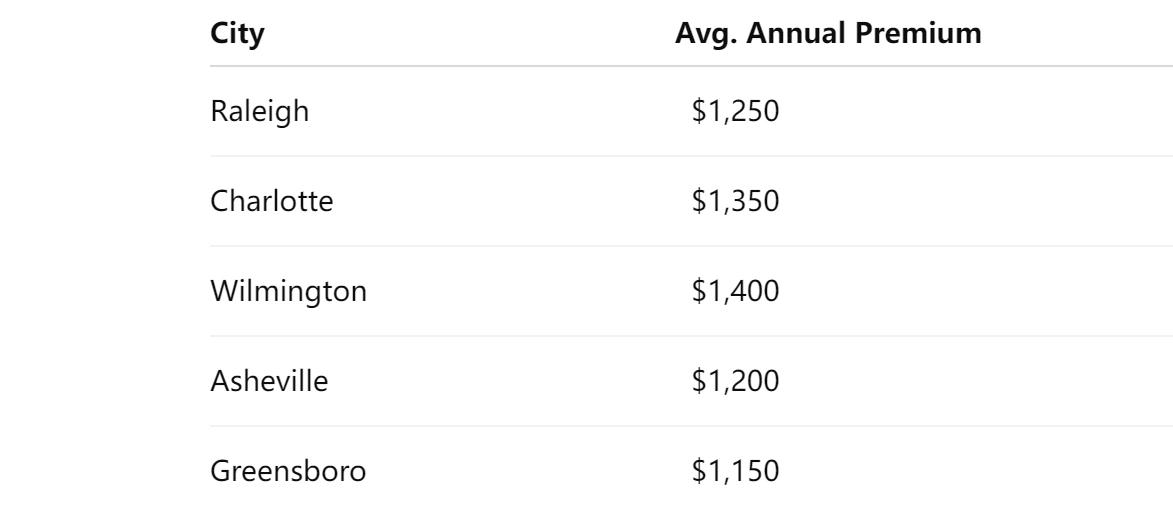North Carolina Home Insurance Guide 2025: Shield Your Tar Heel Home
Published on July 17, 2025
🏠 North Carolina Home Insurance Guide 2025: Shield Your Tar Heel Home
Introduction
Whether you’re near the Atlantic coast or nestled in the Blue Ridge foothills, homeowners insurance in North Carolina must match regional weather and legal exposures. From Outer Banks hurricanes to Asheboro hailstorms and liability claims statewide, securing comprehensive coverage while managing your premium is crucial.
In this guide, we’ll show you how to:
- Choose between HO-3 and HO-5 coverage tailored to your property’s value and local hazards
- Compare average North Carolina home insurance rates in major markets like Raleigh, Charlotte, and Wilmington
- Implement actionable strategies to lower your North Carolina home insurance premium
- Enhance your policy with key endorsements for windstorm, hail, flood, and identity theft protection
1. HO-3 vs HO-5: Matching Coverage to North Carolina Risks
HO-3 (Special Form)
- Named-peril protection for structure and contents (e.g., windstorm, hail, fire, theft)
- Premiums 15–20% lower than HO-5, ideal for standard homes
- Best for: Properties in lower-risk inland or less-exposed coastal areas
HO-5 (Comprehensive Form)
- Open-peril coverage: All risks covered unless explicitly excluded
- Higher personal property limits and broader protection for high-value homes
- Premiums 25–35% higher but minimizes claim denials and out-of-pocket costs
Recommendation: If your rebuild cost or contents exceed $350,000, or if you’re in hurricane or hail corridors, HO-5 ensures full coverage; otherwise, HO-3 offers balanced protection and value.
2. Premium Snapshot: Raleigh, Charlotte & Wilmington
Your ZIP code drives North Carolina home insurance rates. For a 1,900 sq ft home with $300,000 dwelling coverage in 2025, average premiums are:

- Wilmington’s coastal risks uplift rates with hurricane and flood exposure.
- Asheville’s position in the mountains offers lower average premiums thanks to reduced hail and wind frequency.
Always compare North Carolina home insurance quotes by entering your specific ZIP code to uncover local market differences.
3. Core Policy Features for Tar Heel Homeowners
A solid policy should include:
- Dwelling Coverage: Reimbursement to rebuild or repair your home after covered events
- Personal Property: Replacement for belongings damaged or stolen
- Liability Protection: Covers legal and medical costs if someone is injured on your property
- Additional Living Expenses (ALE): Pays for temporary housing if your home is uninhabitable
Pro Tip: Conduct an annual home inventory and update your Replacement Cost Value (RCV) to ensure full reimbursement, especially after renovations or area construction cost increases.
4. Four Proven Tactics to Lower Your Premium
- Enhance Storm Resistance: Upgrade to impact-resistant windows, reinforced roofing, and storm shutters to earn up to 20% mitigation credits.
- Bundle for Savings: Combine home and auto insurance for multi-policy discounts of 10–25%.
- Increase Deductibles Intelligently: Opt for a $2,000–$5,000 deductible if you maintain emergency savings, trimming premiums by 10–20%.
- Protect Your Claims-Free Discount: Handle minor repairs out-of-pocket to keep your no-claims discount intact and avoid rate hikes.
By applying these strategies consistently, you’ll find cheap homeowners insurance in North Carolina without sacrificing essential coverage.
5. Essential Endorsements & Add-Ons
To cover North Carolina–specific perils, consider adding:
- Windstorm & Hail Endorsement: Essential in coastal and piedmont regions; may require a separate 2–5% deductible.
- Flood Insurance: Available through NFIP or private market for flood-prone areas.
- Equipment Breakdown: Protects HVAC, electrical systems, and appliances damaged by power surges or storms.
- Identity Theft Protection: Covers costs related to identity restoration after data breaches.
Incorporating these add-ons turns a basic plan into comprehensive full coverage homeowners insurance in North Carolina.
6. Top-Rated Providers in 2025
Look to these insurers for strong North Carolina offerings:
- State Farm: Large agent network, robust bundling deals, and mitigation incentives.
- Allstate: Digital tools, flexible endorsements, and SafeHome® credits.
- USAA: Premier service and rates for military families.
- Nationwide: Broad coverage options and loyalty perks.
- Farmers Insurance: Custom windstorm, hail, and equipment breakdown endorsements.
Review each carrier’s claims satisfaction ratings and financial strength to select the best homeowners insurance provider in North Carolina.
Conclusion
Securing the right homeowners insurance in North Carolina for 2025 means balancing your premium with comprehensive protection against hurricanes, hailstorms, and liability exposures. By comparing HO-3 vs HO-5 policies, analyzing ZIP-based premiums, and deploying targeted savings tactics, you’ll confidently protect your Tar Heel home and budget.